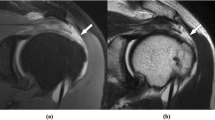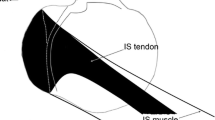Abstract
Purpose
The aim of this study was to evaluate the feasibility of high-resolution magnetic resonance imaging (MRI) using a microscopy coil for the diagnosis of rotator cuff tears by comparing the method to conventional MRI and MRI arthrography.
Materials and methods
A total of 68 shoulders were prospectively studied using a 1.5-T MRI unit. Conventional MRI scans were obtained with a surface coil and high-resolution MRI scans with a microscopy coil. MRI arthrography was performed in 28 shoulders using a surface coil. MRI evaluation of tears of rotator cuff tendons was compared with arthroscopic findings and surgical results.
Results
The surgery revealed 40 full-thickness tears, 13 partial-thickness tears, and 15 intact cuffs. In all, 35 (88%) full-thickness tears were correctly diagnosed on conventional MRI and 40 (100%) on high-resolution MRI. MR arthrography delineated 11 of 12 (92%) full-thickness tears. Altogether, 5 (38%) of the partial-thickness tears were detected on conventional MRI, and 12 (92%) were clearly demonstrated on high-resolution MRI. MRI arthrography depicted three (60%) of five partial-thickness tears. High-resolution MRI showed higher sensitivity than conventional MRI (P < 0.05) and had values equivalent to those of MRI arthrography for diagnosing partial-thickness tears.
Conclusion
High-resolution MRI with a microscopy coil is a feasible, noninvasive technique for diagnosing rotator cuff tears.
Similar content being viewed by others
References
Warner JJ, Goitz RJ, Irrgang JJ, Groff YJ. Arthroscopic-assisted rotator cuff repair: patient selection and treatment outcome. J Shoulder Elbow Surg 1997;6:463–472.
Kneeland JB, Middleton WD, Carrera GF, Zeuge RC, Jesmanowicz A, Froncisz W, et al. MR imaging of the shoulder: diagnosis of rotator cuff tears. AJR Am J Roentgenol 1987;149:333–337.
Evancho AM, Stiles RG, Fajman WA, Flower SP, Macha T, Brunner MC, et al. MR imaging diagnosis of rotator cuff tears. AJR Am J Roentgenol 1988;151:751–754.
Zlatkin MB, Iannotti JP, Roberts MC, Esterhai JL, Dalinka MK, Kressel HY, et al. Rotator cuff tears: diagnostic performance of MR imaging. Radiology 1989;172:223–229.
Flannigan B, Kursunoglu-Brahme S, Snyder S, Karzel R, Del Pizzo W, Resnick D. MR arthrography of the shoulder: comparison with conventional MR imaging. AJR Am J Roentgenol 1990;155:829–832.
Hodler J, Kursunoglu-Brahme S, Snyder SJ, Cervilla V, Karzel RP, Schweitzer ME, et al. Rotator cuff disease: assessment with MR arthrography versus standard MR imaging in 36 patients with arthroscopic confirmation. Radiology 1992;182:431–436.
Ferrari FS, Governi S, Burresi F, Vigni F, Stefani P. Supraspinatus tendon tears: comparison of US and MR arthrography with surgical correlation. Eur Radiol 2002;12:1211–1217.
Meister K, Thesing J, Montgomery WJ, Indelicato PA, Walczak S, Fontenot W. MR arthrography of partial thickness tears of the undersurface of the rotator cuff: an arthroscopic correlation. Skeletal Radiol 2004;33:136–141.
Stetson WB, Phillips T, Deutsch A. The use of magnetic resonance arthrography to detect partial-thickness rotator cuff tears. J Bone Joint Surg Am 2005;87(suppl 2):81–88.
Palmer WE, Brown JH, Rosenthal DI. Rotator cuff: evaluation with fat-suppressed MR arthrography. Radiology 1993;188:683–687.
Mirowitz SA. Normal rotator cuff: MR imaging with conventional and fat-suppression techniques. Radiology 1991;180:735–740.
Reinus WR, Shady KL, Mirowitz SA, Totty WG. MR diagnosis of rotator cuff tears of the shoulder: value of using T2-weighted fat-saturated images. AJR Am J Roentgenol 1995;164:1451–1455.
Quinn SF, Sheley RC, Demlow TA, Szumowski J. Rotator cuff tendon tears: evaluation with fat-suppressed MR imaging with arthroscopic correlation in 100 patients. Radiology 1995;195:497–500.
Singson RD, Hoang T, Dan S, Friedman M. MR evaluation of rotator cuff pathology using T2-weighted fast spin-echo technique with and without fat suppression. AJR Am J Roentgenol 1996;166:1061–1065.
Magee T, Shapiro M, Williams D, Ramnath RR, Simon J. Usefulness of the simultaneous acquisition of spatial harmonics technique during MRI of the shoulder. AJR Am J Roentgenol 2003;181:961–964.
Kijowski R, Farber JM, Medina J, Morrison W, Ying J, Buckwalter K. Comparison of fat-suppressed T2-weighted fast spin-echo sequence and modified STIR sequence in the evaluation of the rotator cuff tendon. AJR Am J Roentgenol 2005;185:371–378.
Tirman PF, Bost FW, Steinbach LS, Mall JC, Peterfy CG, Sampson TG, et al. MR arthrographic depiction of tears of the rotator cuff: benefit of abduction and external rotation of the arm. Radiology 1994;192:851–856.
Lee SY, Lee JK. Horizontal component of partial-thickness tears of rotator cuff: imaging characteristics and comparison of ABER view with oblique coronal view at MR arthrography initial results. Radiology 2002;224:470–476.
Yoshioka H, Ueno T, Tanaka T, Shindo M, Itai Y. Highresolution MR imaging of triangular fibrocartilage complex (TFCC): comparison of microscopy coils and a conventional small surface coil. Skeletal Radiol 2003;32:575–581.
Yoshioka H, Ueno T, Tanaka T, Kujiraoka Y, Shindo M, Takahashi N, et al. High-resolution MR imaging of the elbow using a microscopy surface coil and a clinical 1.5 T MR machine: preliminary results. Skeletal Radiol 2004;33:265–271.
Niitsu M, Ikeda K. Magnetic resonance microscopic images with 50-mm field-of-view of the medial aspect of the knee. Acta Radiol 2004;45:760–768.
Tuite MJ, Asinger D, Orwin JF. Angled oblique sagittal MR imaging of rotator cuff tears: comparison with standard oblique sagittal images. Skeletal Radiol 2001;30:262–269.
Nelson MC, Leather GP, Nirschl RP, Pettrone FA, Freedman MT. Evaluation of the painful shoulder: a prospective comparison of magnetic resonance imaging, computerized tomographic arthrography, ultrasonography, and operative findings. J Bone Joint Surg Am 1991;73:707–716.
Tuite MJ, Yandow DR, DeSmet AA, Orwin JF, Quintana FA. Diagnosis of partial and complete rotator cuff tears using combined gradient echo and spin echo imaging. Skeletal Radiol 1994;23:541–545.
Traughber PD, Goodwin TE. Shoulder MRI: arthroscopic correlation with emphasis on partial tears. J Comput Assist Tomogr 1992;16:129–133.
Rafii M, Firooznia H, Sherman O, Minkoff J, Weinreb J, Golimbu C, et al. Rotator cuff lesions: signal patterns at MR imaging. Radiology 1990;177:817–823.
Fotiadou AN, Vlychou M, Papadopoulos P, Karataglis DS, Palladas P, Fezoulidis IV. Ultrasonography of symptomatic rotator cuff tears compared with MR imaging and surgery. Eur J Radiol 2008;68:174–179.
Tuite MJ, Shinners TJ, Hollister MC, Orwin JF. Fat-suppressed fast spin-echo mid-TE (TE[effective] = 34) MR images: comparison with fast spin-echo T2-weighted images for the diagnosis of tears and anatomic variants of the glenoid labrum. Skeletal Radiol 1999;28:685–690.
Timins ME, Erickson SJ, Estkowski LD, Carrera GF, Komorowski RA. Increased signal in the normal supraspinatus tendon on MR imaging: diagnostic pitfall caused by the magic-angle effect. AJR Am J Roentgenol 1995;165:109–114.
Schneider TL, Schmidt-Wiethoff R, Drescher W, Fink B, Schmidt J, Appell HJ. The significance of sub acromial arthrography to verify partial bursal-side rotator cuff ruptures. Arch Orthop Trauma Surg 2003;123:481–484.
Magee T, Williams D. 3.0-T MRI of the supraspinatus tendon. AJR Am J Roentgenol 2006;187:881–886.
Lambert A, Loffroy R, Guiu B, Mejean N, Lerais JM, Cercueil JP, et al. Rotator cuff tears value of 3.0T MRI. J Radiol 2009;90:583–588.
Author information
Authors and Affiliations
Corresponding author
About this article
Cite this article
Hitachi, S., Takase, K., Tanaka, M. et al. High-resolution magnetic resonance imaging of rotator cuff tears using a microscopy coil: noninvasive detection without intraarticular contrast material. Jpn J Radiol 29, 466–474 (2011). https://doi.org/10.1007/s11604-011-0583-9
Received:
Accepted:
Published:
Issue Date:
DOI: https://doi.org/10.1007/s11604-011-0583-9




